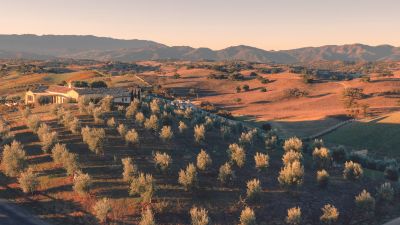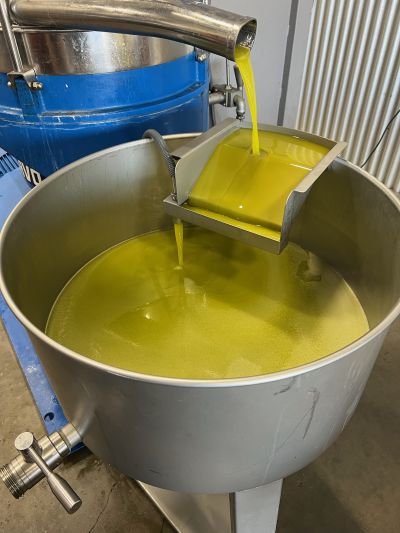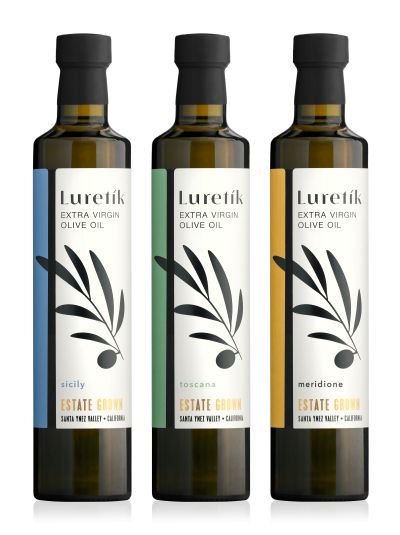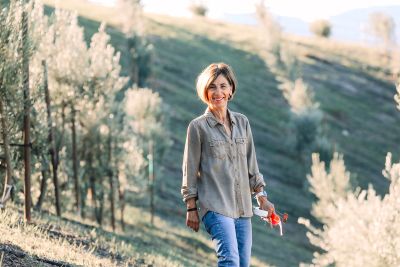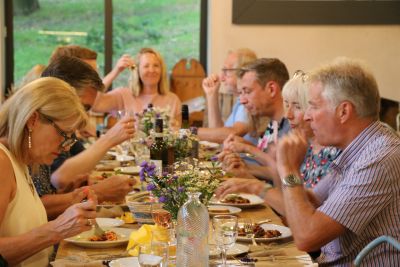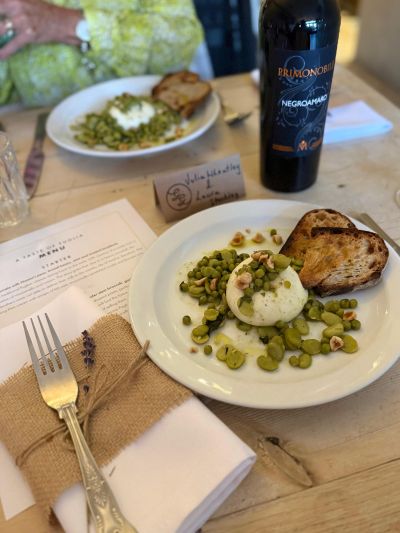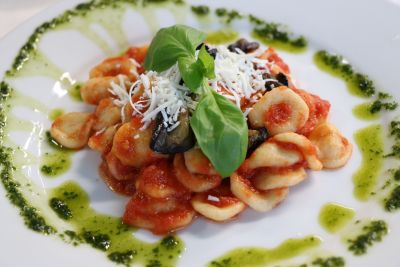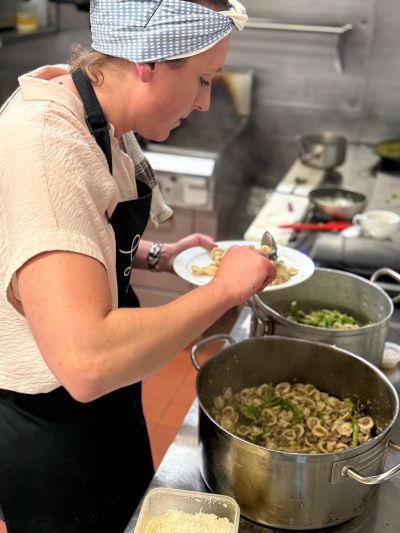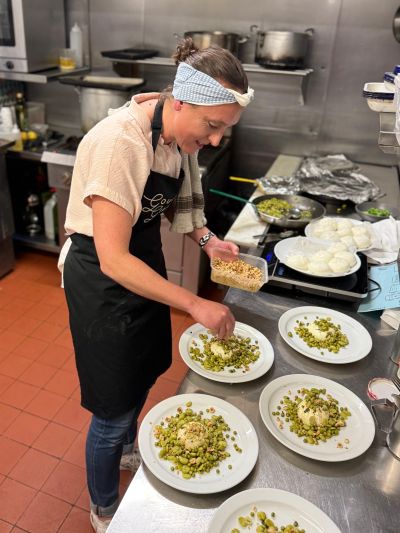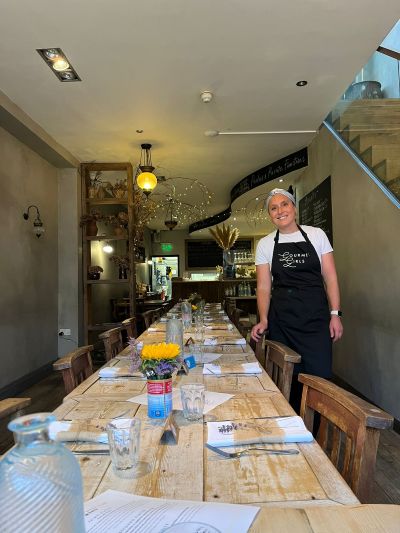In many ways, Elise Magistro's work as an Italian language and literature professor influenced her trajectory to olive growing and oil production.
"Daily contact with Italian language and literature reinforced the prominent role that food (or lack of it in poorer regions) has played in Italian life over the centuries," says Professor Magistro. "Olives and olive oil are woven into the fabric of Italian culture—the literature, art, and cuisine—much like the olive trees that grace the Italian landscape. Although the route wasn't direct, literature led me to connect with many facets of Italian culture, and olive oil was simply one of them. When I knew that my teaching career would be winding down, I found myself heading in that direction as a way to remain connected to Italy."
Drawing from a childhood shaped by her Sicilian paternal grandfather's cooking and memories of her French-Basque maternal grandparents' farming, she left the classroom behind after more than three decades to plant an olive grove in California's Santa Ynez Valley. She has since embraced olive oil production and elevated her region's reputation with internationally acclaimed, award-winning Luretík certified organic extra virgin olive oils.
We talked about her journey and influences, the challenges she's faced, how she chose her olive varieties, the story behind the Luretík name, what sets the brand apart, her advice for business owners, and more.
What inspired your transition from academia to olive growing and oil production?
My relationship with Italy and Italian culture is deeply personal and goes back more than 50 years. When I was young, my grandfather was a constant presence in our home. He was a shoemaker and did not speak much English, but he was an impressive cook and often prepared our daily meals. The dishes were not elaborate, but the quality of the ingredients was excellent, and the food was always prepared with great attention to detail. However, other than our grandfather's cooking and his conversations in Sicilian with my father, there was nothing particularly "Italian" about life in our house. If anything, my mother's Basque traditions figured more significantly in our upbringing. With grandparents who had immigrated from Sicily and France, my siblings and I were aware of our foreign roots but raised to be very American.
I went to Italy for the first time when I was 19 years old. That is where the personal link with my grandfather's linguistic and culinary influences took a surprising turn into a new and exciting cultural territory. In Tuscany, it was a head-over-heels, fall-in-love Stendahl moment: the architecture, the food, the fashion, the daily rituals, the slower pace of life, the intimate connection to a place, all so very different than anything in the U.S. The final leg of my sojourn that year was in Sicily, a visit that brought me full circle back to the world of my grandfather's kitchen. The experience left an indelible mark and was the start of an enduring love affair with Italy.
After completing my undergraduate studies and an M.A. in Italian, I went on to get a PhD, with a focus on southern Italian writers and Italian women's writing. There is often a very regional component in Italian literature, one that reflects the tendency of Italians to identify with their region of birth and to take pride in that identity. (When I first went to Italy, it was far more common for people to introduce themselves as "Siciliani, Toscani, Calabresi," or even with more city specificity as "Palermitani, Fiorentini, Romani" rather than as Italians.)
This regional identity is front and center in Italy's food culture, and olive oil, as everyone knows, figures centrally in Italian cooking. Whenever I was in Italy, I would inevitably end up in people's kitchens, where I discovered that olive oils (depending on the region I happened to be in) all had distinct flavor profiles. Tuscans tended to favor oils made from Frantoio, Leccino, and Moraiolo varieties that are native to the area, while Sicilians favored oils made from Nocellara del Belice, Cerasuola, Biancolilla, and Tonda Iblea olives.
As I would later discover, there are more than 1,200 olive varieties in the world, with roughly 700 found in Italy, most of which are autochthonous or native to a specific region. When I started out, I didn't know anything about growing olives and making olive oil, but the idea of growing different Italian varieties in California soils was very exciting to me. By the time I retired from teaching in 2019, I had already started taking coursework in Italy and at the UC Davis Olive Center in preparation for what was to come.
Luretík olive grove in Santa Ynez Valley. Photo by Jeremy Ball
What challenges did you face at the beginning?
My husband and I decided to buy a piece of property, knowing that we wanted to try our hand at growing olives and producing olive oil. We looked up and down the state, searching for the right spot, and landed in the Santa Ynez Valley, just north of Santa Barbara.
The Santa Ynez Valley is one of the most fertile agricultural areas in California, so growing olives there wasn't so much of the challenge. The closest town to our grove is even called Los Olivos, and the area is blessed with a mild Mediterranean climate, ocean breezes, and ideal soils. Initially, not even water presented much of a worry since olives are fairly drought-resistant. For me, the greater challenge was navigating a world that was completely new, one in which I had zero experience. I talked to everyone, especially agronomists and olive oil experts, as well as to small producers who were having success with their olive operations. I continued to take coursework and read everything I could about soils, water management, tree pruning, pest control, harvest timing, and sound milling practices. And I spent a lot of time in the grove simply observing, something I continue to do today.
To draw a cooking analogy, one can start with the best ingredients and still not end up with a great result. Good soils, great weather, and optimal growing conditions don't guarantee that you will necessarily end up with high-quality olive oil. In the end, my approach to making olive oil was similar to the one I had adopted in my own study of Italian and one that I often shared with my students: "Immerse yourself in the subject and find a way to do so every single day. Repetition and daily contact are the keys to succeeding." At the time, I'm not quite sure I fully realized the scope of what is entailed in producing a high-quality olive oil, but I was committed and have not looked back.
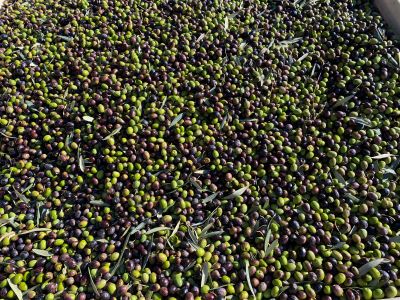
Olives used to produce Luretík extra virgin olive oil are estate-grown.
Tell us about your olive trees.
We purchased our first 50 Nocellara del Belice trees and 50 Cerasuola trees, both Sicilian varieties, in 2012. We kept them in pots in our backyard until we were ready to put them in the grove in 2016. We gradually added more of each, along with other varieties, and nearly a decade later, we are at a little over 1,000 trees, comprising nine Italian cultivars.
I chose Italian varieties for several reasons, not the least of which were sentimental. Sicily and Tuscany were my touchstones, and Sicilian and Tuscan oils had always been my favorites. When we were getting ready to plant, however, I received some very good advice from two small producers in Italy who were guiding us through the process. They encouraged me to be open-minded and to plant a variety of cultivars so we could see which ones adapted best to our California soils. They also noted that the strategy made sense for the overall health of the grove, as pests that attack one variety may ignore another and diseases that strike some varieties might not show up in others. Finally, they insisted that biodiversity would not only help physically protect the grove but also protect my financial investment. It was the best advice I could have gotten. Our Coratina trees (a variety I had never intended to plant) began producing after only two years and have produced one of our most frequently awarded oils.
I continue to spend much of my time in Italy visiting small producers who grow the same varieties we do at Luretík so that I can better understand how to work with a particular cultivar, especially when it comes to timing the harvest and milling olives, as no two olive varieties are the same. Some cultivars in our grove are more sensitive to cold; others are less tolerant of heat. Some varieties come into production after just a couple of years; others take four or five. Some olive varieties mature early; others mature late. But more importantly, the same variety grown in a different geographic area will produce a different oil, and there are harvest timing and milling decisions that will also affect the final product. All these considerations must be taken into account when managing a grove and making a quality olive oil. Finally, I'd say that varietal diversity in our grove has opened up options for blending different oils to create oils with unique sensory profiles.
Olive oil production
How do you choose the blend of olives for each type of olive oil, and what makes them unique?
Italy has a comprehensive database of native cultivars that catalogs the chemical and sensory profiles of over 198 Italian varieties. The site has the additional benefit of tracking taste profiles of oils made from the same cultivar but not grown in the region of origin (important for me as I am growing Italian varieties in California).
I started out with the idea of producing monocultivar oils, but the problem in the beginning was that no single cultivar in the grove was producing enough olives to make more than 20 gallons or so of oil. Rather than simply milling all my olives together and producing a "field blend," which is what people normally do in this situation, I decided to take a certain percentage of olives of one cultivar and mill them together with an equal or lesser percentage of another variety that I thought would produce a pleasant oil.
I based my decisions on what I had learned about the different taste profiles of individual varieties and information gleaned from other Italian producers and databases. While the method was a bit unorthodox (oils are typically blended after having been milled separately), all three of the resulting blends we produced that year were recognized with the highest awards in international competitions. Now, as the grove nears full production, we will be able to mill our varieties separately and blend with more precision. With the help of a professionally trained, expert olive oil taster, I am learning more about this process, and the prospect of continuing on this path is very exciting.
Where does the name Luretík come from?
When it came time to plant the grove, I was looking for an Italian name or something that reflected both the Mediterranean roots of olive oil and the California provenance of our oil. And I was really struggling. My mother, who was Basque and whose parents farmed, suggested the name Luretik. Lure in Basque means earth. And when the suffix -ík is added (luretík), the word translates roughly to "what comes from this ground" or "from my own land." It just seemed perfect, because not everyone grows the olives that go into making their oil. Growing my own olives was a source of pride and important to me, so the name resonated. In the end, the name Luretík was a nod to my mother's Basque farming roots, while the Sicilian cultivars that make the oil honor my father.
You've won numerous international awards. What sets your oils apart on a global scale?
On the one hand, what sets our oil apart is what sets every good oil apart: they are produced with care and attention to every detail in the journey from the grove to the mill. Fruitiness, bitterness, and pepperiness are the three positive characteristics of a quality oil, and in a perfectly crafted oil, these characteristics will be in balance, with one sensory trait never overpowering the other two.
How you arrive at that balance, again, is a combination of many factors, with perhaps the most important being healthy olives that are harvested at the optimal moment, then milled by a knowledgeable miller within 12 to 24 hours of picking.
On a more personal level, I would say that our oils have been recognized because we adhere to the highest standards when making Luretík olive oil. Although we are quite small, we are fully certified organic with an eye on becoming certified sustainable. We have earned the trust of our customers by being principled and transparent about how we make our oils, and maintaining that trust is key for me. In a very real sense, it goes back to the work ethic instilled in me by my parents, and particularly my father. He never told us, so much as showed us, that if you are going to take the time to do something, you need to work as hard as you can. I think that philosophy has paid off for us.
What business advice would you give?
I would say start with the product, because everything else is secondary. If you can find a way to make beautiful oils, all else will fall into place. Before introducing our oil to the broader market in 2022, I wanted to be as informed as possible about all aspects of what I was doing and selling. That is why I still spend much of my time talking with experts and visiting small producers who have been successful over time in maintaining the quality of their oils. Ideally, one should have a sound business plan in place, but I was admittedly a little slower on that front as all my energies were geared towards learning how to farm the olives and make the oil.
Olive oil is having a moment. It seems we read about it everywhere: chefs interested in food pairings, fitness enthusiasts touting health benefits, and marketers looking to create gorgeous packaging for a product that is on everyone's mind. And that is all good for olive oil, but producers should be cautious about feeling the need to get involved in too many areas at the outset. I would argue for a slower approach that is focused on the product.
Elise Magistro - Photo by Jeremy Ball
What do you hope to share?
The world of olive oil is as vast, and for that reason, a lot of what I do is education. Part of my mission is to help people make informed decisions about their choices, especially because there is a great deal of confusion around olive oil. Labeling, for example, has become a minefield of misleading terms. For starters, I try to walk people through the essential terminology on a label so that they can feel more confident about their choices. People have been very responsive about becoming more knowledgeable about olive oil, and that has been gratifying for me.
An equally important part of what I want to share about olive oil, however, is tied to my love of Italy and the historic role olive oil has always played in Italian culture. While almost every trip to Italy still includes stays in Tuscany and Sicily, I am always happy to visit other regions, to learn something new that I can share with others. This olive oil venture is part of a longer journey that started decades ago, and it happily keeps me connected to a country and a culture that I have never ceased to love. I feel very fortunate that I was lucky to do something over the course of my life that kept me so engaged. I could do it forever.
If you enjoyed this article, consider subscribing to my newsletter for more content and updates!

